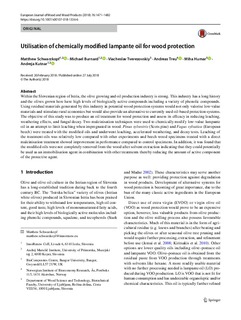| dc.contributor.author | Schwarzkopf, Matthew | |
| dc.contributor.author | Burnard, Michael | |
| dc.contributor.author | Tverezovskiy, Viacheslav | |
| dc.contributor.author | Treu, Andreas | |
| dc.contributor.author | Humar, Miha | |
| dc.contributor.author | Kutnar, Andreja | |
| dc.date.accessioned | 2019-04-11T10:56:22Z | |
| dc.date.available | 2019-04-11T10:56:22Z | |
| dc.date.created | 2018-08-01T09:34:21Z | |
| dc.date.issued | 2018-07-27 | |
| dc.identifier.citation | European Journal of Wood and Wood Products. 2018, 76 (5), 1471-1482. | nb_NO |
| dc.identifier.issn | 0018-3768 | |
| dc.identifier.uri | http://hdl.handle.net/11250/2594221 | |
| dc.description.abstract | Within the Slovenian region of Istria, the olive growing and oil production industry is strong. This industry has a long history and the olives grown here have high levels of biologically active compounds including a variety of phenolic compounds. Using residual materials generated by this industry in potential wood protection systems would not only valorise low-value materials and stimulate rural economies but would also provide an alternative to currently used oil-based protection systems. The objective of this study was to produce an oil treatment for wood protection and assess its efficacy in reducing leaching, weathering effects, and fungal decay. Two maleinisation techniques were used to chemically modify low-value lampante oil in an attempt to limit leaching when impregnated in wood. Pinus sylvestris (Scots pine) and Fagus sylvatica (European beech) were treated with the modified oils and underwent leaching, accelerated weathering, and decay tests. Leaching of the treatment oils was relatively low compared with other experiments and beech wood specimens treated with a direct maleinisation treatment showed improvement in performance compared to control specimens. In addition, it was found that the modified oils were not completely removed from the wood after solvent extraction indicating that they could potentially be used as an immobilisation agent in combination with other treatments thereby reducing the amount of active component of the protective agent. | nb_NO |
| dc.description.abstract | Utilisation of chemically modified lampante oil for wood protection | nb_NO |
| dc.language.iso | eng | nb_NO |
| dc.rights | Navngivelse 4.0 Internasjonal | * |
| dc.rights.uri | http://creativecommons.org/licenses/by/4.0/deed.no | * |
| dc.title | Utilisation of chemically modified lampante oil for wood protection | nb_NO |
| dc.type | Journal article | nb_NO |
| dc.type | Peer reviewed | nb_NO |
| dc.description.version | publishedVersion | nb_NO |
| dc.rights.holder | © The Author(s) 2018 | nb_NO |
| dc.subject.nsi | VDP::Landbruks- og Fiskerifag: 900::Landbruksfag: 910::Skogbruk: 915 | nb_NO |
| dc.subject.nsi | VDP::Landbruks- og Fiskerifag: 900::Landbruksfag: 910::Landbruksteknologi: 916 | nb_NO |
| dc.source.pagenumber | 1471-1482 | nb_NO |
| dc.source.volume | 76 | nb_NO |
| dc.source.journal | European Journal of Wood and Wood Products | nb_NO |
| dc.source.issue | 5 | nb_NO |
| dc.identifier.doi | 10.1007/s00107-018-1336-6 | |
| dc.identifier.cristin | 1599262 | |
| dc.relation.project | EC/H2020/739574 | nb_NO |
| cristin.ispublished | true | |
| cristin.fulltext | original | |
| cristin.qualitycode | 1 | |

